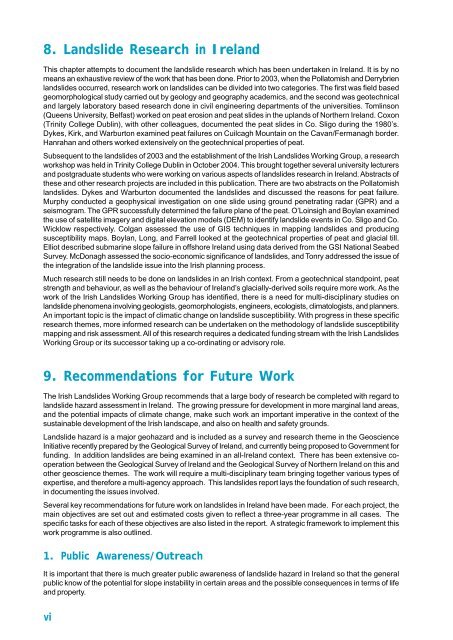to download report - Geological Survey of Ireland
to download report - Geological Survey of Ireland
to download report - Geological Survey of Ireland
- No tags were found...
You also want an ePaper? Increase the reach of your titles
YUMPU automatically turns print PDFs into web optimized ePapers that Google loves.
8. Landslide Research in <strong>Ireland</strong>This chapter attempts <strong>to</strong> document the landslide research which has been undertaken in <strong>Ireland</strong>. It is by nomeans an exhaustive review <strong>of</strong> the work that has been done. Prior <strong>to</strong> 2003, when the Polla<strong>to</strong>mish and Derrybrienlandslides occurred, research work on landslides can be divided in<strong>to</strong> two categories. The first was field basedgeomorphological study carried out by geology and geography academics, and the second was geotechnicaland largely labora<strong>to</strong>ry based research done in civil engineering departments <strong>of</strong> the universities. Tomlinson(Queens University, Belfast) worked on peat erosion and peat slides in the uplands <strong>of</strong> Northern <strong>Ireland</strong>. Coxon(Trinity College Dublin), with other colleagues, documented the peat slides in Co. Sligo during the 1980’s.Dykes, Kirk, and Warbur<strong>to</strong>n examined peat failures on Cuilcagh Mountain on the Cavan/Fermanagh border.Hanrahan and others worked extensively on the geotechnical properties <strong>of</strong> peat.Subsequent <strong>to</strong> the landslides <strong>of</strong> 2003 and the establishment <strong>of</strong> the Irish Landslides Working Group, a researchworkshop was held in Trinity College Dublin in Oc<strong>to</strong>ber 2004. This brought <strong>to</strong>gether several university lecturersand postgraduate students who were working on various aspects <strong>of</strong> landslides research in <strong>Ireland</strong>. Abstracts <strong>of</strong>these and other research projects are included in this publication. There are two abstracts on the Polla<strong>to</strong>mishlandslides. Dykes and Warbur<strong>to</strong>n documented the landslides and discussed the reasons for peat failure.Murphy conducted a geophysical investigation on one slide using ground penetrating radar (GPR) and aseismogram. The GPR successfully determined the failure plane <strong>of</strong> the peat. O’Loinsigh and Boylan examinedthe use <strong>of</strong> satellite imagery and digital elevation models (DEM) <strong>to</strong> identify landslide events in Co. Sligo and Co.Wicklow respectively. Colgan assessed the use <strong>of</strong> GIS techniques in mapping landslides and producingsusceptibility maps. Boylan, Long, and Farrell looked at the geotechnical properties <strong>of</strong> peat and glacial till.Elliot described submarine slope failure in <strong>of</strong>fshore <strong>Ireland</strong> using data derived from the GSI National Seabed<strong>Survey</strong>. McDonagh assessed the socio-economic significance <strong>of</strong> landslides, and Tonry addressed the issue <strong>of</strong>the integration <strong>of</strong> the landslide issue in<strong>to</strong> the Irish planning process.Much research still needs <strong>to</strong> be done on landslides in an Irish context. From a geotechnical standpoint, peatstrength and behaviour, as well as the behaviour <strong>of</strong> <strong>Ireland</strong>’s glacially-derived soils require more work. As thework <strong>of</strong> the Irish Landslides Working Group has identified, there is a need for multi-disciplinary studies onlandslide phenomena involving geologists, geomorphologists, engineers, ecologists, clima<strong>to</strong>logists, and planners.An important <strong>to</strong>pic is the impact <strong>of</strong> climatic change on landslide susceptibility. With progress in these specificresearch themes, more informed research can be undertaken on the methodology <strong>of</strong> landslide susceptibilitymapping and risk assessment. All <strong>of</strong> this research requires a dedicated funding stream with the Irish LandslidesWorking Group or its successor taking up a co-ordinating or advisory role.9. Recommendations for Future WorkThe Irish Landslides Working Group recommends that a large body <strong>of</strong> research be completed with regard <strong>to</strong>landslide hazard assessment in <strong>Ireland</strong>. The growing pressure for development in more marginal land areas,and the potential impacts <strong>of</strong> climate change, make such work an important imperative in the context <strong>of</strong> thesustainable development <strong>of</strong> the Irish landscape, and also on health and safety grounds.Landslide hazard is a major geohazard and is included as a survey and research theme in the GeoscienceInitiative recently prepared by the <strong>Geological</strong> <strong>Survey</strong> <strong>of</strong> <strong>Ireland</strong>, and currently being proposed <strong>to</strong> Government forfunding. In addition landslides are being examined in an all-<strong>Ireland</strong> context. There has been extensive cooperationbetween the <strong>Geological</strong> <strong>Survey</strong> <strong>of</strong> <strong>Ireland</strong> and the <strong>Geological</strong> <strong>Survey</strong> <strong>of</strong> Northern <strong>Ireland</strong> on this andother geoscience themes. The work will require a multi-disciplinary team bringing <strong>to</strong>gether various types <strong>of</strong>expertise, and therefore a multi-agency approach. This landslides <strong>report</strong> lays the foundation <strong>of</strong> such research,in documenting the issues involved.Several key recommendations for future work on landslides in <strong>Ireland</strong> have been made. For each project, themain objectives are set out and estimated costs given <strong>to</strong> reflect a three-year programme in all cases. Thespecific tasks for each <strong>of</strong> these objectives are also listed in the <strong>report</strong>. A strategic framework <strong>to</strong> implement thiswork programme is also outlined.1. Public Awareness/OutreachIt is important that there is much greater public awareness <strong>of</strong> landslide hazard in <strong>Ireland</strong> so that the generalpublic know <strong>of</strong> the potential for slope instability in certain areas and the possible consequences in terms <strong>of</strong> lifeand property.vi
















